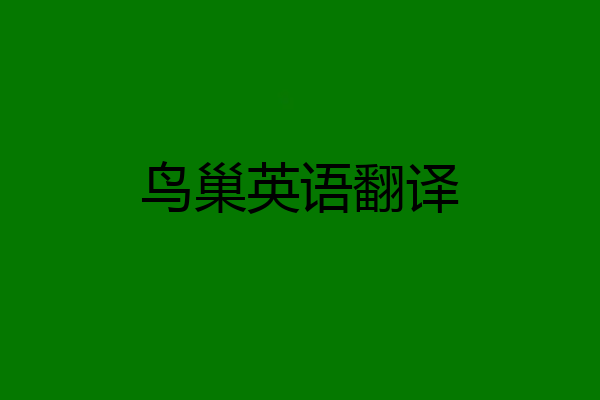
秋末夏初
鸟巢:BeijingNationalStadium(Bird'sNest/OlympicStadium)水立方:NationalSwimmingCenter(ThewaterCube)


追风的夕夕
National Aquatic Center 水立方 Beijing National Stadium (Bird's Nest/Olympic Stadium)鸟巢

永远的怀念!
鸟巢:Beijing National Stadium (Bird's Nest/Olympic Stadium) 水立方:National Swimming Center (The water Cube)

麦生啤酒
bird's nestn.鸟巢, 燕窝鸟巢niǎocháo[nest] 鸟儿为了保存蛋、孵蛋并抚育小鸟而做的住处例句与用法: Tolypella 鸟巢菌目 Nidulariales 杜鹃在别的鸟巢中产卵。 The cuckoo lays its eggs in other birds'nests. 捣毁鸟巢,鸟儿飞掉。 Destroy the nest and the birds will fly away. 沉默蕴蓄着语声,正如鸟巢拥围着睡鸟。 Silence will carry your voice like the nest that holds the sleeping birds. 幼鸟从鸟巢里掉下来了,还不会飞。 The baby bird toppled from the nest unable to fly yet. 猛禽的巢鸟巢,如鹰巢,筑于悬崖或其他高处 The nest of a bird,such as an eagle,built on a cliff or other high place. 风刮得很猛,吹翻了鸟巢,3只雏鸟摔了下去。 The wind blew so strongly that the nest turned upside down and three baby birds fell out. 在黄昏的微光里,有那清晨的鸟儿来到了我的沉默的鸟巢里。 In the dusk of the evening the bird of some early dawn comes to the nest of my silence. 鸟巢鸟用小树枝、草或其它东西做的窝或在里边产卵、养鸟或栖息 A container or shelter made by a bird out of twigs,grass,or other material to hold its eggs and young. 哈哈!

小怪兽的小胖兽
1.北京奥运国家体育场就是俗称的"鸟巢"
"鸟巢"的英文名称是Nest-type Beijing Olympic Stadium或者Beijing National Stadium (Bird's Nest/Olympic Stadium)
鸟巢英文单词是bird nest
2."水立方"的英文是water cube Beijing National Aquatics Cente或water cube
“鸟巢”和“水立方”的英文简介
Beijing National Stadium
The Beijing National Stadium (traditional Chinese: 北京国家体育场; simplified Chinese: 北京国家体育场; Hanyu Pinyin: Běijīng Guojiā Tǐyuchǎng; Tongyong Pinyin: Běijīng Guojiā Tǐyuchǎng), also known as the National Stadium,[1] or the "Bird's Nest" (鸟巢) for its architecture, is a stadium under construction on the Olympic Green in Beijing, China that is scheduled for completion in March, 2008[2]. The stadium will host the main track and field competitions for the 2008 Summer Olympics, as well as the opening and closing ceremonies. It is located right next to the Beijing National Aquatics Centre.
Design
In 2002, Government officials engaged architects worldwide in a design competition. Pritzker Prize-winning architects Herzog & de Meuron collaborated with ArupSport and China Architecture Design & Research Group to win the competition. Contemporary Chinese artist, Ai Weiwei, is the Artistic Consultant for design.[3] The ground was broken on Christmas EveDecember2003, and construction started in March2004, but was halted by the high construction cost in August2004 and continued again. In January 2008, concerns about construction working conditions arose when it was revealed that at least 10 workers had died during the stadium's construction.[4] Controversy also surrounded the alleged forced evictions of many residents so the construction could go ahead.
Capacity
The stadium can seat as many as 91,000 spectators during the Olympics. The capacity will then be reduced to 80,000 after the Games. It has replaced the original intended venue of the Guangdong Olympic Stadium[citation needed]. The stadium is 330 metres long by 220 metres wide, and is 69.2 metres tall. The stadium uses 258,000 square metres of space and has a usable area of 204,000 square metres. It was built with 36 km of unwrapped steel, with a combined weight of 45,000 tonnes. The stadium has some 11,000 square metres of underground rooms with waterproof walls. The stadium will cost up to 3.5 billionyuan (≈423 million USD).
Upon completion, this stadium will boast a state of the art Solar PV system produced by Suntech Power[
Beijing National Aquatics Centre
The Beijing National Aquatics Centre, also known as the Water Cube (or abbreviated [H2O]3 [1]), is an aquatics centre that was built alongside Beijing National Stadium in the Olympic Green for the 2008 Summer Olympics. Ground was broken on December 24, 2003.
Design
In 2002, Government officials engaged architects worldwide in a design competition. Pritzker Prize-winning architects Herzog & de Meuron collaborated with ArupSport and China Architecture Design & Research Group to win the competition. Contemporary Chinese artist, Ai Weiwei, is the Artistic Consultant for design.[3] The ground was broken on Christmas EveDecember2003, and construction started in March2004, but was halted by the high construction cost in August2004 and continued again. In January 2008, concerns about construction working conditions arose when it was revealed that at least 10 workers had died during the stadium's construction.[4] Controversy also surrounded the alleged forced evictions of many residents so the construction could go ahead.
Capacity
The stadium can seat as many as 91,000 spectators during the Olympics. The capacity will then be reduced to 80,000 after the Games. It has replaced the original intended venue of the Guangdong Olympic Stadium[citation needed]. The stadium is 330 metres long by 220 metres wide, and is 69.2 metres tall. The stadium uses 258,000 square metres of space and has a usable area of 204,000 square metres. It was built with 36 km of unwrapped steel, with a combined weight of 45,000 tonnes. The stadium has some 11,000 square metres of underground rooms with waterproof walls. The stadium will cost up to 3.5 billionyuan (≈423 million USD).
Upon completion, this stadium will boast a state of the art Solar PV system produced by
Suntech Power[